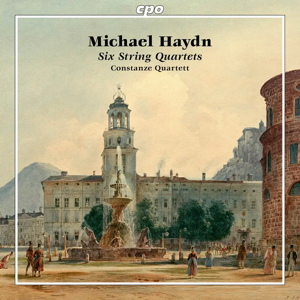
Michael Haydn (1737-1806)
String Quartets MH 308-313 (1770s or 1780s?)
Constanze Quartett
rec. 2020, the Church of the Christian Community, Salzburg, Austria
cpo 555 409-2 [68]
This CD of six string quartets attributed to Michael Haydn arrived just before I left for Salzburg, the city in which the composer lived from 1763 until his death in 1806. The Michael Haydn Museum, part of the DomQuartier Salzburg (Museum St. Peter), will be of interest to admirers of this composer and to anyone interested in eighteenth-century music. Although he was not as famous as his elder brother, Franz Joseph, Michael Haydn’s influence extended well into the nineteenth century. When Franz Schubert, for example, travelled to Salzburg in 1825 on his way to Gasteinertal, he indicated in a letter to his brother Ferdinand that he visited St. Peter’s to pay his respects to Haydn, but did not mention Wolfgang Amadeus Mozart, the city’s most famous composer from our perspective today.
The vast majority of over 800 Haydn works that survive for posterity are sacred, but there are some instrumental compositions among his oeuvre, including the six string quartets on the present CD. With the exception of the four-movement F Major quartet, the others consist of three movements. These quartets, perhaps arising from his duties at the Salzburg court to produce chamber music, bear little resemblance to the masterpieces composed by Franz Joseph Haydn.
The B-flat quartet opens with an Andante commodo that has a marching theme; the Menuetto is an elegant dance, and the concluding Allegro: Rondo has a rustic feel. Giving the first violinist opportunities for virtuosity, the E-flat quartet opens with a lyrical Andante, followed by a Minuetto and an Allegretto. The quartet in A opens with an Andante in 6/8 metre; the second movement is a Menuetto alla Franzese; and the third movement is a brief Rondo. The G minor quartet begins with an Andante un poco allegro in which the first violin is dominant; the second movement is a lyrical Andante grazioso; the final movement, curiously, is a Menuetto. Consisting of four movements, the quartet in F gives each instrument a chance to be dominant in the opening Allegro moderato. The second movement is a Minuetto; the third movement is a poignant Adagio, the only one in the entire set; and the quartet ends with a vivacious Allegro. Concluding the series is a quartet in C with a rhythmic opening Andante un poco Allegro, a fleet Menuetto un poco Allegro, and a vigorous finale Allegro in 6/8 time.
The Salzburg-based Constanze Quartett play with assurance, technical mastery, and elegance: their clarity and tempo choices enable all of the musical lines to be heard. Although this repertoire is unfamiliar, they treat it with the same level of care usually lavished upon famous quartets (e.g., those Franz Joseph Haydn).
The recorded sound is pleasingly natural, ambient, and richly detailed. As usual, cpo sets a high standard for presentation: the CD is housed in a standard jewel case with a booklet containing an essay in German with an English translation and a beautiful painting of the Residenzplatz in Salzburg from 1844 on the cover.
Daniel Floyd
Buying this recording via a link below generates revenue for MWI, which helps the site remain free.




















